Welcome back to Inside the Sketchbook — a series dedicated to exploring the methods, mediums and mindsets of the next generation of artists. In our second instalment of blog posts, we’re talking to more incredible, up-and-coming creatives who are making their mark on the world, through their sketchbooks.
Next up, we caught up with Sarah Wilson; a recently freelance illustrator and animator who paints dreamy pictures of life in all its beautiful forms.
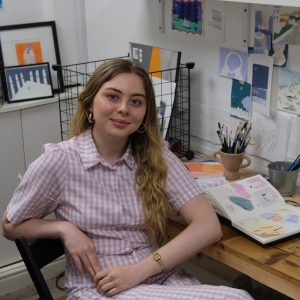
What’s your artistic backstory?
I feel like being an artist has always been in me. When I was growing up, my mum always said I was creative, I was happy to sit on my own, and do what I wanted; painting, crafting — things like that. But I don’t remember thinking of myself as outwardly “arty”. No one in my family has a creative job, and I think I first realised I had a passion for art when I was in school. I had a really great art teacher, and she really supported me and got me excited about the subject — to the point where I used to ask to work throughout my lunchtimes and stay late on projects. When I left school, I did all arty A-levels, and studied Illustration at Manchester School of Art (MMU) so my love for it has truly grown through my education; steering me in this creative direction which, in turn, nurtured my passions and personal work.
How have you found your feet and progressed since graduating?
It’s been a bit of a rollercoaster, same as everyone. I had no clue what I wanted to do. I didn’t want to be a freelancer at first — it seemed really stressful — so I got a job in the industry, but once I’d built up my confidence, I took a leap of faith and put myself out there. It wasn’t easy, I had to find my feet and overcome all kinds of obstacles, but then in January, almost out of nowhere, it all just seemed to click and the right work was coming in. After getting to the point of thinking “I’ve made the wrong decision”, suddenly I realised it was all so right.
What’s your proudest artistic achievement to date?
Last year, I was having a really bad year, like most, through the pandemic and mental health struggles — lots of questioning of myself about what I had achieved, and feeling like I wasn’t doing what I was truly passionate about. So in that respect, going freelance was my biggest achievement. It kind of hit me, when everyone was at home, that I just had to take the plunge and become a freelancer. Finding my own unique style has been really rewarding. Sometimes you need a push, and being at breaking point like that was what I needed to realise what I really wanted.
What do you want people to feel when they see your work?
Calm — like they’re in a dream. Like this partly familiar, but also strange place. There are some weird things going on, but it’s not scary. It’s just this kind of dreamworld, full of escapism and tranquillity.
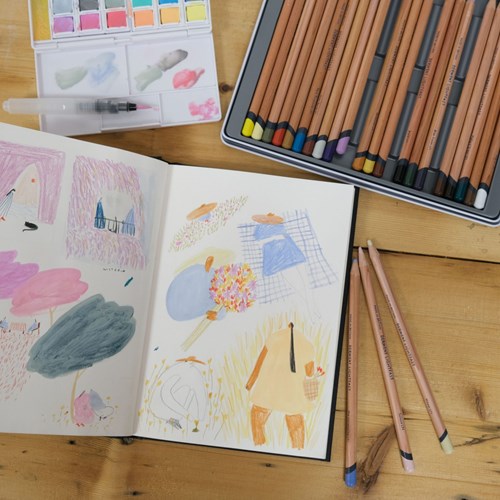
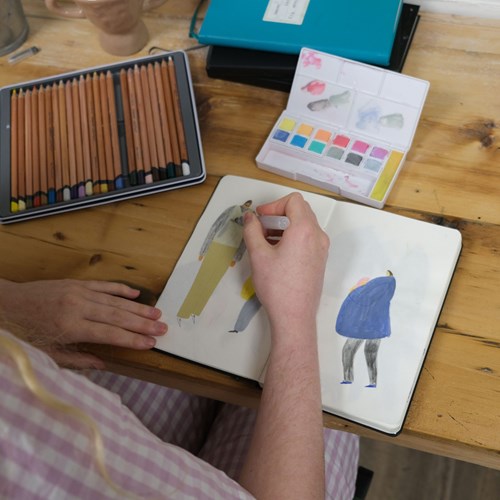
Who or what are the ‘characters’ in your work inspired by?
Anyone and no one. They’re not linked to anyone in particular, they’re just generally inspired by people I’ve seen out and about — observation is a really important part of my creative process. I like them to be kind of ambiguous, and for people to look at them and create their own story, questioning where they’ve come from, what their relationship to the scene is and other characters that feature in the piece. I personally see my characters as figures you’d meet in a dream; they’re familiar but you can’t quite place them.
There is a real sense of warmth, love and community that transpires through your work, would you say that this reflects your life and/or self in any way?
I like exploring themes of love and friendship in my work. I have a very strong set of close friends — the kind where you get a bit older, you’ve found your people, there’s no aggression, everyone is happy and harmonious. And the same with my partner and family, we don’t really fall out and we’re all very peaceful.
When it comes to a sense of community, I’ve always lived in a big city. I grew up in Nottingham and I live in Manchester now, so I’ve always been surrounded by lots of diverse groups of people, and I like that to come through in my work. I’m quite nosey as well, I love seeing people, couples especially, and thinking “what are the nice things they might do together?”, and tell that story through my work.
There is a beautiful and extensive range of colours used across your work, what influences the colour palette?
I take a lot of inspiration from flowers, especially poppies and wildflowers. I also love the work of Hilma af Klint and her use of pastels. I’m drawn to those kinds of shades, with big injections of bold colours, like hot pink and yellow. But it doesn’t come naturally to me, the use of colour, I have to be very methodical about it, even if that’s not how it looks on the page.
How do you stay true to your original style?
I think it’s really important to work on what you like. I really enjoy the research — sometimes more than completing the final piece — finding quirky little objects and surreal subject matters.
It’s very easy to be influenced by ‘art trends’, but when it comes to developing your style you have to explore what interests you personally, which allows you to develop something that is unique and authentic to you. My partner always says, “it’s better to look forwards than sideways”, and that’s so true. It’s better to focus on yourself rather than what everyone else is doing — that is definitely the key to finding your style and staying true to it.
Why is it so important to use quality materials?
As an artist, you have to find the materials that suit your work. It’s the final piece of the puzzle — matching them to the idea. I’ve experimented with so many different materials, and I’ve very much found my own in gouache and watercolour. It’s so important to have good quality gouache and watercolour, because the results can vary so drastically. The pigment needs to be vivid otherwise I’m just not going to enjoy it. It also means, when the quality is there, that I’m creating work that I don’t have to edit on screen which is so much more authentic to my style because I’m creating the finished piece straight directly on the page.
What does Derwent (as a brand) mean to you?
Derwent has always been there for artists. It’s a brand you become aware of when you’re starting out and because of that, I’ve always regarded the products as high quality, but not intimidating. Which means you can approach them as both a hobbyist and a professional, which is so unique.
How has the Pastel Paint Pan Set helped you to best create the piece you’ve designed for this campaign?
The Pastel Paint Pan Set has been a great addition to my kit, as I chose to paint my piece outside. Which is something I don’t typically do due to me finding paints quite problematic and messy to set up when out and about. But the set is really compact and easy to use, the colours are also colours I’d typically use in my work, so I now feel more comfortable with painting whilst on my daily walks.
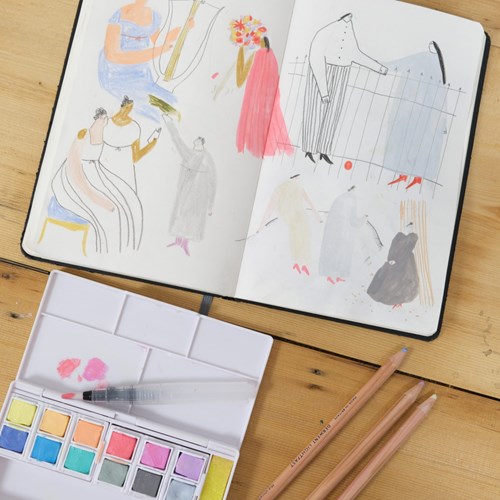
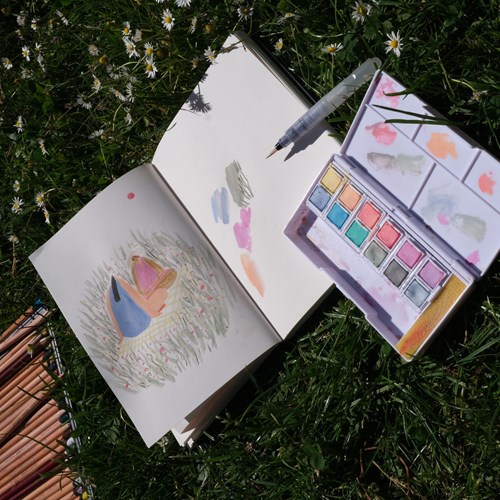
Can you give us a three word review of the Pastel Paint Pan Set?
User-friendly, vibrant, versatile.
How do Derwent’s art supplies help you create the perfect piece?
I like how well the dry materials combine with the wet materials. I think sometimes when working with mixed media, the products don’t marry together well! But the Derwent collection has been well considered with this in mind. I’ve found combining the Pastel Paint Pan Set’s colours with the Lightfast Pencils layered over the top, works really well in achieving the perfect texture in my work.
Thank you for Sarah for taking some time out of her day to speak with us. Stay tuned to our Inside the Sketchbook series, as our talented line up of up-and-coming artists tell us their stories and unpack their work.